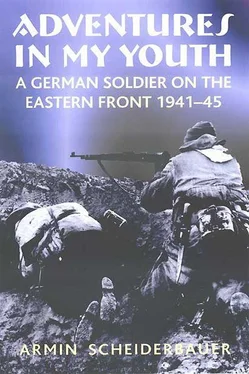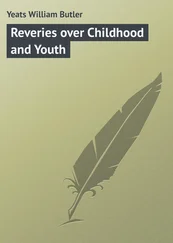It was only on 14 July that I had to transfer into the first platoon of the company, to take over the section of a NCO who was going on leave. A week or so later we officer cadets were assembled in Shabino, near to the regimental command post. We had to take yet one more ‘revision course’ before our promotion to NCO. That was expected on 1 August. The course was given by Oberleutnant Steiff, the then regimental adjutant. (I met him again in 1975 in Vienna, where, as a Brigadegeneral in the German Bundeswehr, he was taking part in the negotiations which dragged on for years concerning bilateral reduction of forces in Europe). As far as we could see, the reason for the course was that the regimental commander wanted to get an idea of our theoretical knowledge and capabilities.
On 1 August I was proud to tell my Mother and sisters that, together with the five other officer cadets, I had been promoted to Fahnenjunkerunteroffizier , Officer Cadet NCO. On that occasion three of them received the EK II, Iron Cross 2nd Class. I was very pleased because ‘my appendix didn’t stop me’. Because I was a few days short of the minimum 2 months’ probation period at the front, in actual fact I should not have been allowed the promotion. However, the commander, Oberstleutnant von Eisenhart-Rothe, a gaunt gentleman with the elegance of a cavalryman, and evidently of a similar elegance in thinking, took the responsibility upon himself. Then, I wrote to my Mother, I had a salary, and the business of ‘public assistance for the children’ was at an end.
The previous day we sat together and wrote to our nearest and dearest ‘with liquor and cigars’. The ‘official’ celebration of our promotion, with the commander and some officers from the regimental Staff, was planned for the evening. Our celebration was part of it, because after the commander had left, Oberleutnant Roy, the commander of the 13th Infanteriegeschütz Company, took over the presidency of the Corona and we moved up into so-called ‘increased drinking’. (I met Roy, who, despite his twenty-five years, even back then had a bald patch, at the Division reunion in Stuttgart. While reminding him of that evening in Shabino, I told him that it was he I had to thank for getting drunk worse than I ever had in my life.) It happened that Roy, himself a drinker of note, ordered us officer cadets to drink up in turn.
Finally, ‘to conclude the evening’, he got me to gulp down within five minutes all the drink remaining in the glasses on the table. I managed it, too, under the astonished eyes of my comrades. But after a while I had to be taken back to my quarters while being held up on both sides. But I must not have been able to manage to stay there for the rest of the night, because towards morning I found myself lying in the ferns beside the cottage in which we had our quarters. That was the end of the promotion celebrations. It was the next day, when I was already back with my company, before I got over the hangover.
I then took over the 8th section of the company again. On a piece of paper I had written down for myself the names, dates of birth, occupations and addresses of my men. The slip of paper I had folded twice and placed in my field hymn book. That little book, 5 x 7.5cm in size and ½cm thick, was an Army regulation (No. 371), in a Protestant and a Catholic edition. It contained, in addition to the professional duties of the German soldier, the oath before the colours, and also extracts from the war letters of German soldiers killed in action. It had prayers beginning with the Our Father to the prayers In Gefahr , In danger, and In der Todesstunde , At the Hour of Death, for the dying. There were prayers for burials, chorales and hymns, and finally Bible texts designated as ‘essential sayings’.
My men were —
Füsilier Werner Mutz, born 30 April 1923 in Stolp (Pomerania), a shopkeeper in Stolp,
Gefreiter Helmut Budewizk, born on 4 March 1922 in Hamburg, a student in Berlin-Steglitz,
Gefreiter Albert Vickendey, born on 3 April 1913 in Rickensdorf, Kreis Helmstedt (Brunswick), blacksmith in Brunswick,
Gewehrschütze 1: Obergefreiter Anton Neumann, born on 11 December 1910 in Himmelwitz, Upper Silesia, tailor in Himmelwitz,
Gewehrschütze 2: Füsilier Wladimir Stamer, born on 26 July 1909 in Sosnowitz, Upper Silesia, baker’s assistant in Gleiwitz,
Gewehrschütze 3: Füsilier Otto Beer, born on 2 December in Süptitz, Kreis Torgau, agricultural worker in Süptitz.
My deputy section leader was
Obergefreiter Rudolf Iwanek, born 20 October 1919 in Vienna, automobile painter in Vienna.
I can see the faces of almost all those men in my mind’s eye, as I read their names, even though I have never seen any of them since. I knew that Mutz was killed in action a few days later, and that Budewizk, a happy lad with a friendly face, was posted missing.
Though I had reported from my post on sentry duty ‘nothing unusual to report’ to the company commander, the situation for the battalion suddenly changed drastically. I quote from the regimental history:
Of the fighting in which individual units were involved with divisions other than their own, the action of II./ Infanterieregiment 7 (Vielhauer), parts of Panzer-Jäger Abteilung 252, 14./ Infanterieregiment 7, 14./ Infanterieregiment 461 under Oberst Karst as Kampfgruppe leader should be mentioned. The alarm was sounded on 12 August 1942.
Some 50km south of Gshatsk, in the region of the 3rd Panzer-Armee , and the area of IX Armeekorps and XX Armeekorps , the Soviets had succeeded in breaking into the positions of the divisions. They were the 183rd Infanteriedivision and the 292nd Infanteriedivision . Especially in the area of the 183rd Infanteriedivision , the Russians had succeeded in penetrating deep into the main combat area. A breakthrough threatened.
The Kampfgruppe was loaded on lorries and driven up to the main highway leading south from Gshatsk. They were unloaded in Upolosy and placed under the command of the 292nd Infanteriedivision . Marching up beside the road, partly on ‘corduroy’ roads, the scattered II./ Infanterieregiment 7 reached Ssilenki to take a rest. A supply dump that was being dismantled served to strengthen the unit. Hordes of Army baggage handlers were fleeing back to the rear, parts of the baggage-train and flak units were getting ready to flee. All of that characterised the situation. Although it all reeked of retreat in disorder, the Kampfgruppe was in the kind of mood to advance. In a wood near Ssawinki west of the highway, positions were taken up facing south.
To the east of the highway II./ Infanterieregiment 131 had taken up position. That battalion, too, was placed under the command of Kampfgruppe Karst. Further to the east was a gap up to II./ Infanterieregiment 351. It appeared that eastwards there was a coherent front, but the situation to the west of the positions of II./ Infanterieregiment 7 was completely unclear. There the 183rd Infanterieregiment appeared to have been broken through. Scarcely had II./ Infanterieregiment 7 hastily dug into the woodland, at about 8pm on 14 August 1942, than the enemy armoured attack began. It was beaten back with bloody casualties.
Further armoured attacks followed in which it was mostly only individual tanks that succeeded in breaking the main line of resistance. The few anti-tank weapons did not succeed in dispatching the tanks that had broken through, so the infantry had to do it at close range. After an unquiet night, on 15 August, at 6.15am the Soviets again attacked with armour and infantry. With the energetic support of the artillery, it was possible to repulse all enemy attacks. But to the west of the position the Soviets had succeeded in pushing forward through a gap towards Besmino. By striking out widely, they encircled II./ Infanterieregiment 7. With Kampfgruppe Karst taking up a position of all-round defence, it was possible to block the highway successfully further on.
Читать дальше












